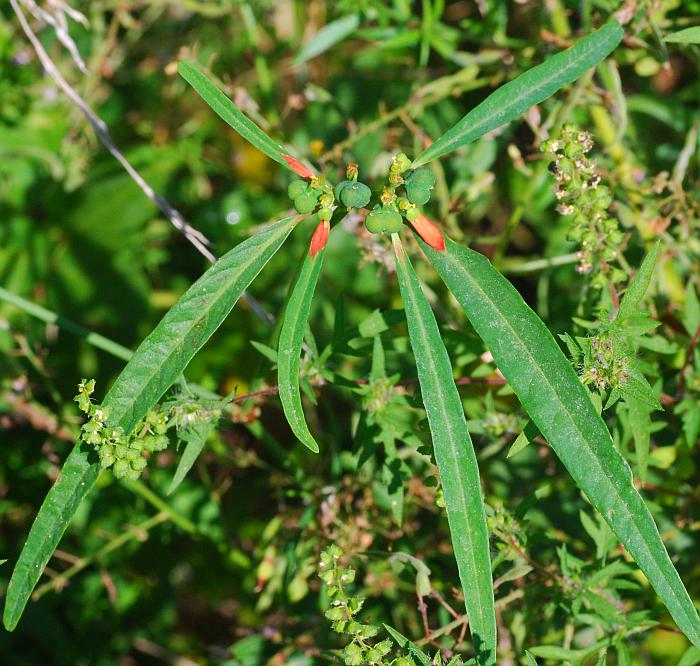Euphorbia cyathophora Murray
Painted Leaf

Native
CC = 4
CW = 3
MOC = 57
© SRTurner
Euphorbia cyathophora MurrayPainted Leaf | |
 |
Native CC = 4 CW = 3 MOC = 57 |
© SRTurner |
Family - Euphorbiaceae Habit - Taprooted annual forb. Stems - Ascending to erect, to 100 cm, unbranched to several-branched, the branches not flattened toward the tip, usually green to yellowish green, occasionally reddish-to purplish-tinged, glabrous or with sparse multicellular hairs around the nodes.
Leaves - Alternate above the lowest node and below the inflorescence branches (those of the lowermost node and the inflorescence branches usually opposite), mostly short-petiolate. Stipules absent or a pair of minute, light brown, convex, sessile glands. Leaf blades 15-150 mm long, highly variable in shape, linear to lanceolate, elliptic, ovate, or broadly elliptic, those of the upper leaves sometimes pinnately few-lobed, symmetrically angled or tapered at the base, rounded or angled to tapered to a sharply pointed tip, the margins entire or toothed, the upper surface glabrous, bright green and (on the uppermost leaves) sometimes with a bright red to reddish purple (rarely pink, yellow, or white) region toward the base, the undersurface glabrous or sparsely pubescent with relatively stout, multicellular hairs, light green to pale green.
Inflorescences - Terminal at the branch tips (not an umbellate panicle with a whorl of leaves at the base), of solitary or more commonly paired cyathia, sometimes appearing as small clusters.
Cyathia - Involucre 2.0-2.5 mm long, glabrous, the rim irregularly lobed and fringed, the marginal glands 1 or less commonly 2, 0.7-1.5 mm long, appearing strongly concave and more or less 2-lipped, yellowish green to yellowish brown, lacking a petaloid appendage. Staminate flowers 30-50 per cyathium. Ovaries glabrous, the styles 0.8-1.1 mm long, each divided 1/2-2/3 of the way from the tip into 2 slightly club-shaped lobes.
Fruits - Schizocarps 3-4 mm long (nearly twice as broad), 3-lobed, glabrous. Seeds 2.5-3.0 mm long, ovate to oblong-ovate in outline, circular in cross-section, more or less flattened to slightly concave at the base, the surface with a network of low, sharp ridges or wrinkles and low, pointed tubercles, dark brown with the tips of the ridges and tubercles lighter brown, usually lacking a caruncle, a minute, discolored, slightly raised area occasionally present. Flowering - July - October. Habitat - Streambanks, bases of bluffs, bottomland forests, fields, gardens, roadsides, open disturbed areas. Origin - Native to the U.S. Other info. - This striking species can be found throughout much of Missouri but is apparently uncommon or absent from much of the north-central portion of the state. Beyond Missouri its range includes much of the U.S. Midwest and southern states. The plant frequently gets yellow to red splotches at the base of the upper leaf blades, a feature which is a great aid to identification when present, but which does not always occur. In fact, the great variability leaf shape and color was responsible for the name which was long in use for the plant: Euphorbia heterophylla; however, that name is properly applied to a tropical species which does not occur here. The plant is related to the poinsettias which are popular around Christmas, and in fact another name which has been used for the plant is Poinsettia heterophylla. Photographs taken off Hwy 60, Polk County, Fl., 2-13-03, and in Ellington, MO., 7-7-03 (DETenaglia); also at Forest 44 Conservation Area, St. Louis County, MO, 9-6-2010 (SRTurner). |